Foreign language skills statistics
Data extracted in April 2019.
Planned article update: June 2024.
Highlights
In 2016, 24.8 % of working-age adults in the EU who knew at least one foreign language reported that they knew their best-known foreign language at a proficient level.
In 2016, more than 80 % of the adult working-age population of the EU with a tertiary level of education knew at least one foreign language.
Population aged 25–64 reporting they knew one or more foreign languages, 2016
This article presents an overview of European Union (EU) statistics related to self-reported foreign language skills. It provides information on the number of foreign languages known, as well as levels of command/proficiency. The data are analysed by age, sex, level of educational attainment, labour status, occupation and degree of urbanisation. Note that data for some EU Member States may be missing depending upon the type of analysis being conducted [1].
This article is one of a set of statistical articles forming part of an online publication on education and training; it provides a complement to information on foreign language learning statistics. The data presented in this article are all derived from the adult education survey (AES).
Full article
Number of foreign languages known
Around two thirds of working-aged adults in the EU knew at least one foreign language
In 2016, over one third (35.4 %) of the working-age adults (defined here as 25–64 year-olds) in the EU-28 reported that they did not know any foreign languages. A similar proportion (35.2 %) reported that they knew one foreign language, while just over one fifth (21.0 %) knew two foreign languages, and fewer than one tenth (8.4 %) of all working-age adults knew three or more foreign languages.
An analysis by sex reveals that there was almost no gender gap in relation to foreign language skills. In 2016, a slightly higher share of men did not know any foreign languages or knew only one foreign language (both 36.1 %) compared with the corresponding share for women (34.8 % and 34.3 % respectively). However, the share of women who knew two foreign languages (22.1 %) was 2.2 percentage points higher than that for men, and the share of women who knew three or more foreign languages (8.9 %) was also higher than that recorded for men (7.9 %).
What constitutes a foreign language?
Interest in foreign language skills centres on the ability of Europeans to communicate in an efficient way: with information collected in relation to the most commonly used languages and levels of language competence/skill. When conducting the adult education survey (AES) respondents are asked to name the language(s) they use as their mother tongue. They are subsequently asked to provide information on other languages that they may know.
A ‘mother tongue’ is understood to mean the first language learned at home in childhood and still understood by the individual at the time of the adult education survey (AES). In bilingual homes, the language of either the father or of the mother could be the most dominant, in the sense that it is used for in-house communication, or it could be that both the languages of the mother and father are used, in which case the respondent has more than one ‘mother tongue’.
Note there are cases among the EU Member States where there is more than one ‘official language’ — for example, in Belgium there are three (German, French and Dutch). However, it is not necessarily the case that these official languages coincide with the ‘mother tongue(s)’ of the respondent and if they only speak one of these at home, then the others are considered (for the purpose of this article) as foreign languages.
In a similar vein, a relatively large proportion of people living in the EU were not born in the Member State where they are resident. Many of these people may well have a different mother tongue from the official language(s) where they are resident, for example, a person who has Russian as their mother tongue living in the United Kingdom. When the survey is conducted this person should reply that Russian is their ‘mother tongue’, while (for the purpose of this article) English would be considered as a foreign language (given the respondent had some knowledge of the English language).
It is important to note that — in spite of the existence of these rules to be applied when collecting the AES data — countries may also implement national preferences when building their questionnaires. The following specificity in particular has been reported to Eurostat about the national collection of foreign languages: Slovakian was not considered as a foreign language in the Czech survey up to the AES 2011, while Czech is considered as a foreign language in all waves of the Slovakian survey.
More than half of the adult working-age population in Luxembourg knew three or more foreign languages
The extent of multilingualism differed considerably between the EU Member States. The share of the adult working-age population who reported that they knew three or more foreign languages peaked at 51.2 % in Luxembourg, while the next highest shares were recorded in Finland (44.9 %) and Slovenia (37.7 %). In contrast, less than 3.0 % of the adult working-age populations of Greece, Hungary, Poland and Romania reported that they knew three or more foreign languages.
In 2016, more than half of the adult working-age populations of Bulgaria (50.5 %), Hungary (57.6 %), Romania (64.2 %) and the United Kingdom (65.4 %) reported that they did not know any foreign language. In contrast, there were eight EU Member States in 2016 where less than 10.0 % of the population reported that they knew no foreign languages. Among these, the lowest share was recorded in Sweden, where less than 4.0 % reported that they did not know any foreign language.

(%)
Source: Eurostat (edat_aes_l21)
Upwards of 9 out of every 10 individuals of working-age knew at least one foreign language in the Nordic Member States and the Baltic Member States as well as in Luxembourg and Malta
In 16 EU Member States, more than three quarters of the adult working-age population reported that they knew at least one foreign language in 2016. At least 9 out of every 10 adults of working-age reported that they knew at least one foreign language in Sweden (96.6 %), Latvia (95.7 %), Denmark (95.7 %), Lithuania (95.6 %), Luxembourg (94.5 %), Finland (92.1 %), Malta (91.8 %) and Estonia (91.2 %).
Figure 1 provides an analysis of the extent of multilingualism in the EU Member States. The very high proportion of working-age adults in Luxembourg who reported speaking at least three foreign languages may, at least in part, reflect the local administrative (where there are three official languages) and education systems (where most pupils receive instruction in Luxembourgish, German and French at a primary level of education, with English and other languages being introduced at secondary level). Luxembourg also has a high share of foreign nationals working in an international environment: in 2016, some 57.7 % of the resident population aged 25–64 was born in a foreign country.
Some of the other EU Member States that displayed high degrees of multilingualism in 2016 are characterised by their geographical and linguistic proximity. For example, it is relatively common for people from some of the Nordic, Baltic, and eastern EU Member States to understand the languages of some of their neighbours. Some Member States have more than one official language: for example, there are three in Belgium (German, French and Dutch) and two in Finland (Finnish and Swedish), while minority languages exist in others, for example, in Slovenia the official language is Slovenian, with Italian and Hungarian considered as co-official languages.
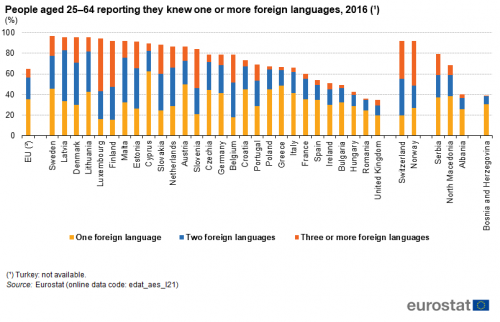
(%)
Source: Eurostat (edat_aes_l21)
Analysis of those knowing one or more foreign languages
There appears to be a clear generation gap favouring younger people in relation to self-reported foreign language skills. Figure 2 presents information related to those people who reported they knew at least one foreign language with an analysis by age group.
Younger people tended to report greater foreign language skills …
In 2016, about three quarters (73.3 %) of the EU’s population aged 25–34 reported that they knew at least one foreign language. This share fell for each successive age group, with the lowest proportion recorded among those aged 55–64. Nevertheless, more than half (55.1 %) of the age group 55–64 declared that they knew at least one foreign language.
This gap between the generations was most pronounced among those EU Member States that reported a relatively low share of their adult working-age populations knowing at least one foreign language. In Greece, 86.6 % of the population who were aged 25–34 reported that they knew at least one foreign language, compared to 40.4 % among those aged 55–64 — a difference of 46.2 percentage points. Based on the same comparison (between the youngest and oldest age groups), there were also considerable generation gaps (33–39 percentage points difference) in foreign language skills in Croatia, Hungary, Portugal and Romania.
In contrast, this gap between the generations was relatively small in those EU Member States where a high proportion of the adult working-age population knew at least one foreign language. Lithuania was the only EU Member State where the share of the older generation (those aged 55–64) who knew at least one foreign language was higher than the corresponding share for the youngest age group (those aged 25–34), with a gap of 0.3 percentage points. In Lithuania and Latvia (and Estonia to a lesser degree), the relatively high proportion of older persons who speak at least one foreign language may reflect the fact that the older generations learnt Russian, whereas the younger generations learnt English.

(%)
Source: Eurostat (edat_aes_l22)
… as did those with a tertiary level of education …
Aside from a generational gap, there also appears to be an educational gap in relation to foreign language skills as shown for the adult working-age population (25–64 years-old) in Figure 3. In 2016, more than 8 out of 10 (82.5 %) people in the EU who had completed a tertiary level of education (ISCED 2011 levels 5 to 8) reported that they knew at least one foreign language. The corresponding share among those with an intermediate level of education (ISCED levels 3 and 4) was approximately two thirds (63.1 %), falling to 41.7 % among those with a low level of education (ISCED levels 0 to 2).
In 2016, more than 90 % of the adult working-age population with a tertiary level of education knew at least one foreign language in the majority of the EU Member States. Some 75–87 % of those with a tertiary level of education knew at least one foreign language in all but two of the remaining Member States. In the United Kingdom less than half (45.9 %) of this subgroup knew at least one foreign language, and in Ireland it was less than two thirds (64.8 %).
In 2016, there were seven EU Member States where at least three quarters of the adult working-age population with a low level of education reported that they knew at least one foreign language. In contrast, there were 13 Member States where less than half of the population with a low level of education knew at least one foreign language, a share that fell to less than 10 % in Romania and Hungary.
As for the analysis by age, the gap in foreign language skills between the different levels of education was most pronounced for those EU Member States which had a relatively low share of their adult working-age populations knowing at least one foreign language. This was particularly true in Greece, Croatia, Poland, Bulgaria, Hungary and Romania, where the share of the population with a tertiary level of education who reported they knew at least one foreign language was 63–78 percentage points higher than the corresponding share among those with a low level of education.
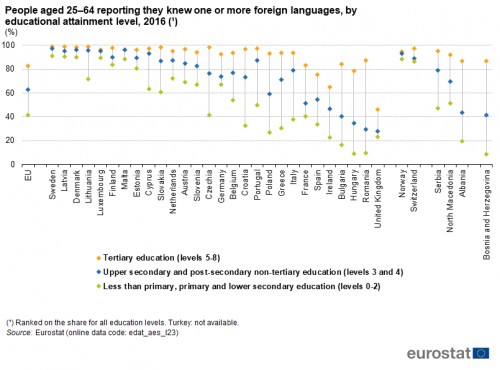
(%)
Source: Eurostat (edat_aes_l23)
… and those who were in employment
Figure 4 provides an analysis with a breakdown according to labour status. In 2016, 68.0 % of the EU’s adult working-age population who were employed reported that they knew at least one foreign language. This proportion fell among those who were unemployed to 58.6 %, while the corresponding share among inactive persons — those outside of the labour force — was 54.9 %. These figures may support the view that, at least for some jobs, employers are keen to engage people who have some foreign language skills, or to promote the learning of foreign languages as part of a training strategy for their staff.
The gap in foreign language skills between people in different labour market situations was most pronounced for those EU Member States which had a relatively low share of their adult working-age populations (aged 25–64) knowing at least one foreign language. In 2016, more than four fifths of the inactive people in Romania did not know any foreign language, while there were ten other EU Member States where more than half of the inactive population reported no foreign language skills. Just over half of the unemployed persons in Spain did not know a foreign language, while in Hungary this share rose to around three quarters of the unemployed.
The United Kingdom, Romania and Hungary were the only EU Member States to report that less than half of those in employment (aged 25–64) knew at least one foreign language. By contrast, there were ten EU Member States where more than 9 out of 10 employed persons knew at least one foreign language, with this share passing above 95 % in Luxembourg, Denmark, Latvia, Lithuania and Sweden.

(%)
Source: Eurostat (edat_aes_l24)
A high proportion of managers, professionals, technicians and associate professionals declared that they knew at least one foreign language
The final analysis presented in this section relates to the proportion of people aged 25–64 who reported they knew at least one foreign language, broken down by occupation. In 2016, 79.3 % of all managers, professionals, technicians and associate professionals in the EU-28 knew at least one foreign language. Corresponding shares were also relatively high among clerical support, service and sales workers (66.7 %), whereas approximately half of those employed as skilled manual workers (53.4 %) or in elementary occupations (48.7 %) knew at least one foreign language; the latter group covers those providing domestic help, cleaners, refuse collectors, as well as those who manually assemble components, sort, pack or deliver goods.
A majority of the managers, professionals, technicians and associate professionals working in each of the EU Member States reported that they knew at least one foreign language. In contrast, there were eight EU Member States where more than half of the skilled manual workers did not know any foreign language (the highest share being in Romania, at 76.4 %), and there were nine EU Member States where more than half of those with an elementary occupation did not know any foreign language (the highest share was in Romania, at 85.4 %). The biggest gaps in foreign language skills between occupations tended to be observed in those EU Member States which had a relatively low share of their adult working-age populations knowing at least one foreign language.
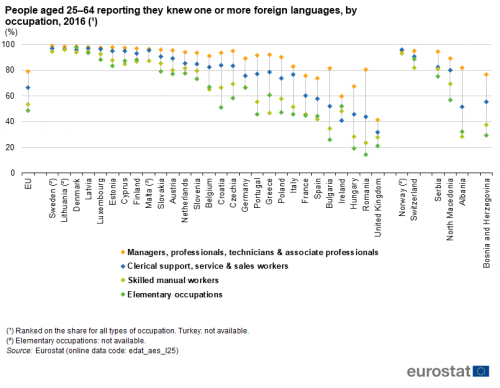
(%)
Source: Eurostat (edat_aes_l25)
Level of command of best known foreign language
The following section examines the level of command, or proficiency, of foreign language skills within the EU. Note that the data presented refers to self-reported proficiency for those who knew at least one foreign language. Furthermore, the measure of proficiency is given only in relation to the best-known foreign language in those cases where a person knows more than one foreign language.
The share of those declaring they were proficient in their best-known foreign language increased between 2007 and 2016 …
In the EU, almost one quarter (24.8 %) of working-age adults who knew at least one foreign language reported that they knew their best-known foreign language at a proficient level. Table 2 presents the level of foreign language skills among adults of working-age in 2007, 2011 and 2016. Within the EU, the share who declared that they were proficient in their best-known foreign language rose by 3.4 and 1.1 percentage points respectively over the two periods under consideration, from 20.3 % in 2007.
There was a larger increase between 2007 and 2011 in the proportion of people in the EU who declared they were good at their best-known foreign language, as this share rose from approximately one quarter (24.3 %) to one third (32.4 %) but this share decreased between 2011 and 2016 by 2.1 percentage points. In contrast, the proportion of working-age adults who declared they were basic in their best-known foreign language fell from 51.3 % to 43.4 % between 2007 and 2011 and rose again to 44.6 % in 2016.
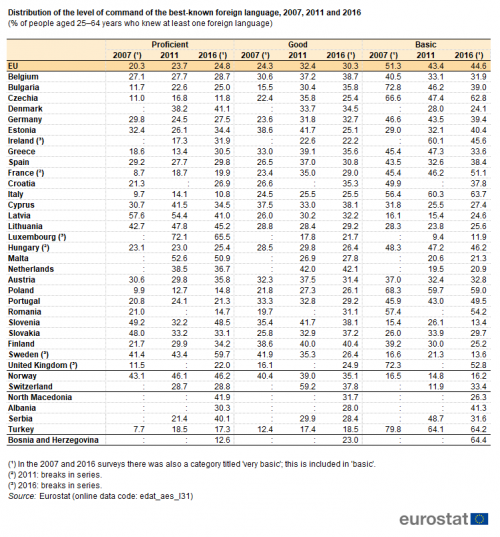
(% of people aged 25–64 years who knew at least one foreign language)
Source: Eurostat (edat_aes_l31)
… but the situation is quite different from one country to another …
Between 2007 and 2016 the share of working-age adults who declared that they were proficient in their best-known foreign language fell in 5 out of the 23 EU Member States for which data are available (see Table 2 for coverage); the largest reductions were recorded in Latvia and Slovakia. In contrast, there was a relatively fast increase in the share of individuals who declared that they were proficient in their best-known foreign language in Sweden (note there is a break in series; see ‘Data sources and availability’ for more details), Bulgaria and Finland.
In 2016, almost three quarters (65.5 %) of the population in Luxembourg declared that they were proficient in their best-known foreign language (see Figure 6). Sweden (59.7 %) and Malta (50.9 %) were the only other EU Member States to report that more than half of their working-age populations declared they were proficient in their best-known foreign language.
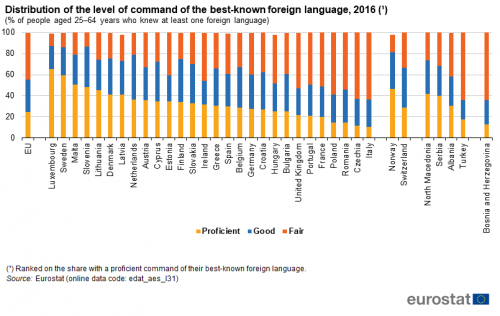
(% of people aged 25–64 years who knew at least one foreign language)
Source: Eurostat (edat_aes_l31)
In contrast, there were five EU Member States in 2016 where fewer than one fifth of the individuals who knew at least one foreign language declared that they were proficient in their best-known foreign language: France, Poland, Romania, Czechia and Italy (where the lowest share was recorded, at 10.8 %).
Analysis of those who consider themselves proficient in their best known foreign language
Figure 7, on the one hand, provides an overview for the EU of the different analyses of foreign language proficiency. Figures 8–12, on the other, provide information for the EU Member States.
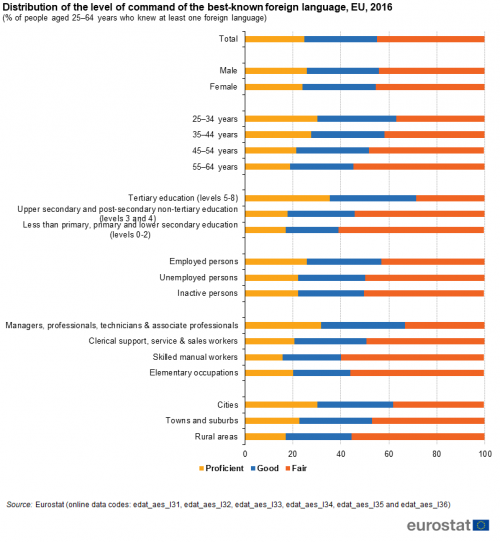
(% of people aged 25–64 years who knew at least one foreign language)
Source: Eurostat (edat_aes_l31), (edat_aes_l32), (edat_aes_l33), (edat_aes_l34), (edat_aes_l35) and (edat_aes_l36)
Focusing on those individuals aged 25–64 in the EU who spoke at least one foreign language in 2016, the highest degrees of foreign language proficiency by sex, age, level of education, labour market status, occupation and degree of urbanisation were recorded for those who were male, young (25–34 years-old), tertiary-educated, employed, occupied as a manager, professional, technician or associate professional and living in a city.
A higher proportion of people aged 25–34 were proficient in their best-known foreign language …
In 2016, the share of individuals who reported that they were proficient in their best-known foreign language was generally higher among younger age groups. For the whole of the EU, more than one quarter (30.1 %) of the population aged 25–34 reported that they were proficient in their best-known foreign language, compared with only 18.7 % of the population aged 55–64.
This pattern was repeated across most of the EU Member States. The highest share of foreign language proficiency was recorded for those aged 25–34 in all but six of the EU Member States. The exceptions were Slovenia, Belgium, France, the United Kingdom, Lithuania and Latvia.
At the other end of the range, those aged 55–64 recorded the lowest shares of foreign language proficiency in all but two of the EU Member States; the only exceptions were Greece and Lithuania.
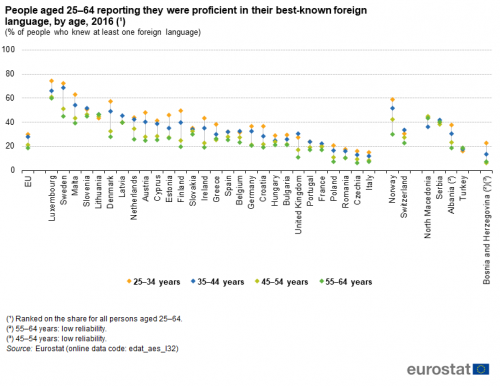
(% of people who knew at least one foreign language)
Source: Eurostat (edat_aes_l32)
… a pattern that was repeated for those with a tertiary level of education …
Across the EU there was a clear link between foreign language proficiency and levels of educational attainment. This may, at least in part, be explained by some tertiary students improving their foreign language proficiency as a result of having to continue their foreign language studies during tertiary education, while others may choose or be required to follow courses whose instruction is given in a foreign language.
In 2016, more than one third (35.4 %) of the EU’s working-age population with a tertiary level of education reported that they were proficient in their best-known foreign language. This was almost twice as high as the share of proficient linguists recorded among those with an intermediate level of education or with a low level of education (17.8 % and 17.1 % respectively).
An analysis across the EU Member States shows that the share of individuals who reported that they were proficient in their best-known foreign language was consistently higher among those with a tertiary level of education, irrespective of whether a comparison was made against those with an intermediate or even lower level of education. This pattern held across each of the EU Member States. This educational gap was particularly evident in Malta where the share of individuals who reported that they were proficient in their best-known foreign language was more than 40 percentage points higher for those with a tertiary level of education than for those with a low level of education. The largest differences in linguistic proficiency between those with a tertiary and an intermediate level of education were recorded in Greece, Austria and Cyprus.
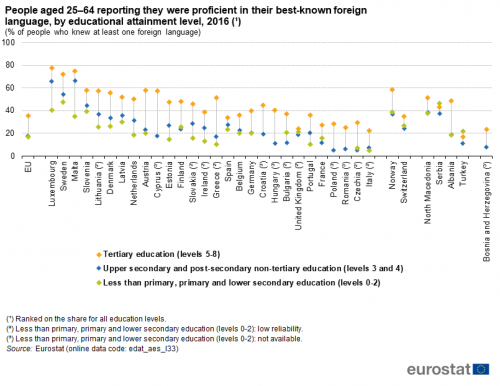
(% of people who knew at least one foreign language)
Source: Eurostat (edat_aes_l33)
… those who were employed ...
Figure 10 shows that employed persons tended to have a higher level of foreign language proficiency. In 2016, one quarter (25.7 %) of those aged 25–64 in the EU who were employed and who knew at least one foreign language reported that they were proficient in their best-known foreign language. The corresponding shares recorded for unemployed persons and inactive persons (22.2 % each) were somewhat lower.
In a majority of the EU Member States, it was common to find that employed persons had the highest level of foreign language proficiency when compared with the shares recorded among unemployed and inactive persons of the same age.
In 2016, the gap in levels of foreign language proficiency between people with different labour market status was most pronounced for those EU Member States which had the highest levels of proficiency. This was particularly true in Luxembourg, Malta, Cyprus, Latvia and Lithuania, where the share of employed individuals who reported that they were proficient in their best-known foreign language was 15–26 percentage points higher than the lowest share (recorded either for the unemployed or for inactive persons). There were however some exceptions to this general pattern, as there were six EU Member States where a higher share of unemployed people (rather than employed people) reported that they were proficient in their best-known foreign language; this was the case in Portugal, the Netherlands, Denmark, France, Ireland and the United Kingdom. In a similar vein, more than one quarter (29.3 %) of the inactive persons in Germany reported that they were proficient in their best-known foreign-language, which was 2.0 percentage points higher than the share recorded among employed persons.

(% of people who knew at least one foreign language)
Source: Eurostat (edat_aes_l34)
Figure 11 presents information relating to the share of working-age adults who reported that they were proficient in their best-known foreign language, with an analysis by occupation. In 2016, the highest share (31.8 %) of foreign language proficiency in the EU was recorded for managers, professionals, technicians and associate professionals. This was considerably higher than for the other three groups of occupations shown in Figure 11, as around one fifth of those employed in elementary occupations (20.2 %) and clerical support, service and sales (20.6 %) reported that they were proficient in their best-known foreign language, while this share fell to 15.6 % among skilled manual workers.
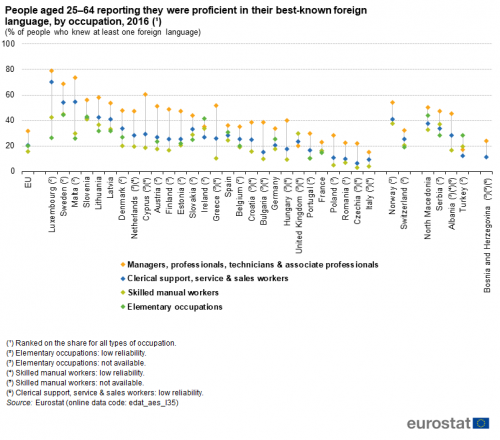
(% of people who knew at least one foreign language)
Source: Eurostat (edat_aes_l35)
… and those who lived in cities
Figure 12 shows that persons living in cities reported a higher share of being proficient in their best-known foreign language that those living in towns and suburbs and in rural areas (30.1 %, 22.7 % and 17.0 % respectively) in the EU in 2016.
The same pattern (highest in cities and lowest in rural areas) was found in 22 EU Member States. Ireland, Luxembourg and the United Kingdom have highest shares in cities but lowest shares in towns and suburbs while Malta and Latvia recorded their highest shares in towns and suburbs. Lastly, Spain is the only Member State with the highest share in rural areas. In 2016, the gap in levels of foreign language proficiency between people living in areas with different degrees of urbanisation was more pronounced in Lithuania, Denmark, Cyprus and Finland (from 20 to 24 percentage points), and peaking at 33.8 percentage points in Austria.
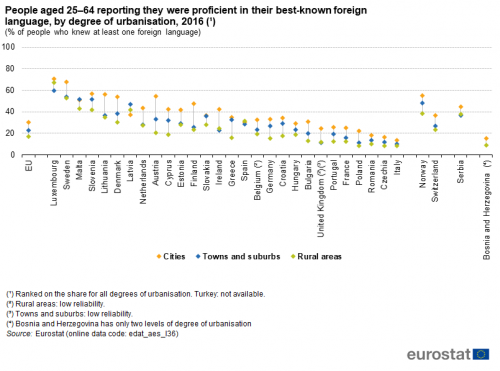
(% of people who knew at least one foreign language)
Source: Eurostat (edat_aes_l36)
Source data for tables and graphs
Data sources
Key concepts
Within the adult education survey (AES) of 2011, three levels of foreign language knowledge were identified:
- Basic — “I can understand and use the most common everyday expressions. I use the language in relation to familiar things and situations”;
- Good — “I can understand the essential of clear language and produce simple text. I can describe experiences and events and communicate fairly fluently”;
- Proficient — “I can understand a wide range of demanding texts and use the language flexibly. I master the language almost completely”.
Note that the AES of 2007 and 2016 had a fourth level of foreign language knowledge:
- Very basic — “I only understand and can use a few words”.
In order to facilitate comparisons between 2007/2016 and 2011 the information collected for this fourth category in 2007 and 2016 has been added to the category covering ‘basic’.
Data source
The adult education survey (AES) is the source of all information in this article. Among others, the AES provides information on self-reported foreign language skills, in contrast to foreign language qualifications that may be obtained within the formal education system or from specialist language schools. The AES focuses on people aged 25–64.
Three waves of the AES have been implemented so far, in 2007, 2011 and 2016. The 2007 AES was a pilot exercise and was carried out on a voluntary basis, while the 2011 and 2016 AES were underpinned by a legal act (Commission Regulation (EU) No 823/2010 and Commission Regulation (EU) No 1175/2014).
Specific breaks in series related to self-reported language skills: two countries in particular reported a methodological break between the 2007 AES and the 2011 AES.
- Belgium: the 2007 AES was a stand-alone self-completion survey and people that have participated in education and training activities were more inclined to answer the questionnaire (non-participants would more easily tend to not send any response). Therefore the profile of the respondents was slightly specific ('active learners') which could have led to a bias in the share of people knowing foreign languages. In the 2011 AES, the intervention of interviewers explaining the purpose of the questionnaire before self-completion lead to a better representativeness of the whole population which can account for a lower share for people being able to speak foreign languages. 2016 AES was again implemented as a stand-alone survey.
- Czechia: up to the 2011 AES, Slovakian was not considered as a foreign language in the Czech survey. On the other hand Czech is considered as a foreign language in the Slovakian survey in all waves.
Note on symbols used in tables
The colon (‘:’) is used to show where data are not available.
Context
The modern world is increasingly characterised by interactions that extend well beyond the confines of national borders. Within the EU, this development can be seen for example in the single market and the free movement of individuals. On a wider scale, globalisation, economic growth in developing economies, and improved transport infrastructure have resulted, among others, in a considerable shift in world trading patterns and a higher proportion of the world’s population being able to visit other countries, whether for business, pleasure or other reasons.
Language and cultural barriers are two aspects which restrict the level of geographic mobility within the EU. By contrast, foreign language skills have the potential to increase the mobility, employability and personal development of Europeans. Indeed, they can give individuals a competitive advantage in labour markets: this is particularly true for those working in senior management, multinational firms or sales and marketing.
English language skills are well-established as an important (business) skill, and English is by far the most widely-spoken foreign language in the EU. Alongside the importance of English, in a world of increasing international exchanges, the ability to speak other foreign languages is of particular importance in large markets where there is relatively little English spoken — for example, in China, Brazil or Russia.
In September 2008, the European Commission adopted a Communication titled ‘Multilingualism: an asset for Europe and a shared commitment’ (COM(2008) 566 final), which was followed in November 2008 by a Council Resolution on a European strategy for multilingualism (2008/C 320/01). These addressed languages in the wider context of social cohesion and prosperity and focused on actions to encourage and assist citizens in acquiring language skills. The Resolution invited the EU Member States and the European Commission to:
- promote multilingualism with a view to strengthening social cohesion, intercultural dialogue and European construction;
- strengthen lifelong language learning;
- promote (better) multilingualism as a factor in the European economy’s competitiveness and people’s mobility and employability;
- promote linguistic diversity and intercultural dialogue by increasing assistance for translation, in order to encourage the circulation of works and the dissemination of ideas and knowledge in Europe and across the world;
- promote EU languages across the world.
The strategic framework for European cooperation in education and training (ET 2020) provides a common set of objectives for EU Member States and seeks to:
- enable citizens to communicate in two languages in addition to their mother tongue;
- promote language teaching in vocational education and training (VET) and for adult learners;
- give migrants the opportunity to learn the language of their host country.
‘Rethinking education: investing in skills for better socio-economic outcomes’ (COM(2012) 0669 final) was adopted by the European Commission in 2012. It promotes a range of ideas, including that the ability to speak a foreign language:
- is an important factor for competitiveness;
- is an important attribute for those seeking work;
- may remove an obstacle to free movement.
The Communication also called on several EU Member States to improve their capacity for providing adequate teaching resources for basic skills (that include numeracy, literacy and foreign languages). A European Commission staff working document titled Language competences for employability, mobility and growth (SWD(2012) 372 final) accompanied the release of the ‘Rethinking education’ Communication. One section of the document looked at foreign language skills as a means for enhancing employability, mobility and growth. It emphasised the importance of raising the general level of foreign language skills, broadening the range of foreign languages taught, and re-orienting teaching content towards professional purposes.
Direct access to
- Education and training in the EU — facts and figures (online publication)
- All pages on education and training
- Foreign language learning statistics
- Education and training, see:
- Languages (educ_lang)
- Self-reported language skills (educ_lang_00)
- Number of foreign languages known (edat_aes_I2)
- Number of foreign languages known (self-reported) by sex (edat_aes_l21)
- Number of foreign languages known (self-reported) by age (edat_aes_l22)
- Number of foreign languages known (self-reported) by educational attainment level (edat_aes_l23)
- Number of foreign languages known (self-reported) by labour status (edat_aes_l24)
- Number of foreign languages known (self-reported) by occupation (edat_aes_l25)
- Number of foreign languages known (self-reported) by degree of urbanisation (edat_aes_l26)
- Level of best-known foreign language (edat_aes_I3)
- Level of the best-known foreign language (self-reported) by sex (edat_aes_l31)
- Level of the best-known foreign language (self-reported) by age (edat_aes_l32)
- Level of the best-known foreign language (self-reported) by educational attainment level (edat_aes_l33)
- Level of the best-known foreign language (self-reported) by labour status (edat_aes_l34)
- Level of the best-known foreign language (self-reported) by occupation (edat_aes_l35)
- Level of the best-known foreign language (self-reported) by degree of urbanisation (edat_aes_l36)
- Level of the foreign language reported as best-known in the country (edat_aes_I5)
- Level of the foreign language reported as best-known in the country (self-reported) by sex (edat_aes_l51)
- Level of the foreign language reported as best-known in the country (self-reported) by age (edat_aes_l52)
- Level of the foreign language reported as best-known in the country (self-reported) by educational attainment level (edat_aes_l53)
- Level of the foreign language reported as best-known in the country (self-reported) by labour status (edat_aes_l54)
- Level of the foreign language reported as best-known in the country (self-reported) by occupation (edat_aes_l55)
- Level of the foreign language reported as best-known in the country (self-reported) by degree of urbanisation (edat_aes_l56)
- Number of foreign languages known (edat_aes_I2)
- Self-reported language skills (educ_lang_00)
- Languages (educ_lang)
News releases
- The EU has reached its target for share of persons aged 30 to 34 with tertiary education — news release
- 65 % know at least one foreign language in the EU
- 84 % of primary school children study foreign languages in 2015
- 60 % of lower secondary level pupils studied more than one foreign language in 2015 — news release
- What languages are studied the most in the EU?
Statistical books
- Key data on education in Europe 2012 — statistical book
- Key data on teaching languages at school in Europe 2012 — statistical book
- Adult education survey (ESMS metadata file — trng_aes_12m0_esms)
- Adult education survey — reference manuals
- European Commission — An agenda for new skills and jobs
- European Commission — Education and training — adult learning
- European Commission — Education and training — skills and qualifications
- European Commission — Education and training — strategic framework for education and training
- European Commission — Language levels — self-assessment grid
- European Commission — Languages — learning languages
- European Commission — Supporting language diversity in Europe
Notes
- ↑ Ireland and Luxembourg did not participate in the 2007 adult education survey; Croatia did not participate in the 2011 adult education survey.